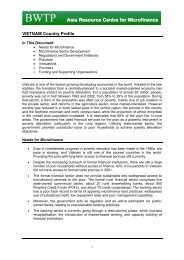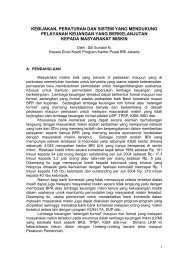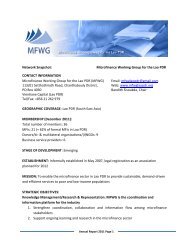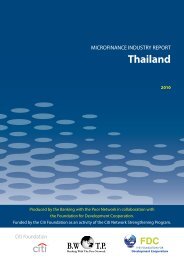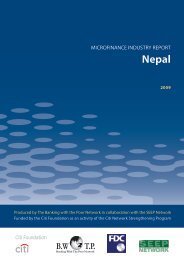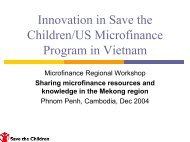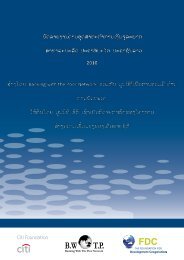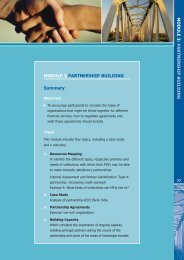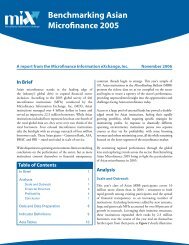microfinance industry report - Vietnam - Banking with the Poor Network
microfinance industry report - Vietnam - Banking with the Poor Network
microfinance industry report - Vietnam - Banking with the Poor Network
You also want an ePaper? Increase the reach of your titles
YUMPU automatically turns print PDFs into web optimized ePapers that Google loves.
Several informal savings and credit groups<br />
complete <strong>the</strong> crowded but fragmented market<br />
for <strong>microfinance</strong> in Viet Nam. These local, semistructured<br />
and truly ‘private’ informal finance<br />
entities exist in almost every hamlet of Viet Nam<br />
as a well-integrated part of <strong>the</strong> communal safety<br />
net. They include Rotating Savings and Credit<br />
Associations (ROSCAs), referred to as Ho in <strong>the</strong><br />
North and Hui in <strong>the</strong> South. In <strong>the</strong> ROSCAs, periodic<br />
savings contributions from members are pooled<br />
and disbursed to one member at a time on a<br />
rotating basis. Interest rates, membership and loan<br />
amounts are decided on ei<strong>the</strong>r jointly, by a bidding<br />
process, or by <strong>the</strong> organizer. Similar savings and<br />
credit groups are also operated among many mass<br />
organization members at <strong>the</strong> local level. As in most<br />
o<strong>the</strong>r developing countries, traders, shopkeepers<br />
and money lenders have been an important source<br />
of informal credit in Viet Nam. Interestingly, <strong>the</strong>re<br />
are <strong>report</strong>s that money lenders have started to<br />
reduce <strong>the</strong>ir lending rates as a consequence of<br />
<strong>the</strong> increasing outreach of formal and semi-formal<br />
financial service providers.<br />
Table 16. Nine Fast Facts about Microfinance in Viet Nam<br />
<strong>Vietnam</strong>ese MFOs vs. <strong>the</strong>ir Global Peers – Nine Fast Facts<br />
The “typical” <strong>microfinance</strong> organization (MFO) in Viet Nam differs in many ways from those elsewhere in Asia or <strong>the</strong> world, as<br />
benchmarked by <strong>the</strong> Microfinance Bulletin. Below are nine of <strong>the</strong> most salient points that make <strong>Vietnam</strong>ese MFOs unique:<br />
1. They are not privately owned. Due to <strong>the</strong> absence of a legal framework for MFIs and <strong>the</strong> ‘Viet Nam-specific’ role that mass<br />
organizations have, all MFOs in Viet Nam are owned by public or semi-public entities, even if independent management<br />
boards may be in place. Licensing under Decrees 28/165 will legalize private ownership structures, which commercial<br />
investors in general prefer.<br />
2. They are small. They have fewer clients and smaller loan portfolios than <strong>the</strong>ir international peer MFIs. Their average<br />
number of clients is half <strong>the</strong> global average of MFIs and one-third of <strong>the</strong> average for Asian MFIs, even at similar age. Their<br />
average loan portfolio is one tenth of <strong>the</strong> international average for MFIs.<br />
3. They have lower (recorded) expenses, both in terms of operational and financing costs, than <strong>the</strong>ir international peers.<br />
This may be because <strong>Vietnam</strong>ese MFOs receive a number of implicit subsidies from <strong>the</strong> Women’s Union ranging from free<br />
rent to heavily-subsidized credit officers’ salaries.<br />
4. Because <strong>the</strong> costs are lower, <strong>Vietnam</strong>ese MFOs are better able to cover <strong>the</strong>ir (<strong>report</strong>ed) expenses than international<br />
MFIs (as measured by OSS).<br />
5. They are more poverty-focused by having a smaller loan sizes than <strong>the</strong>ir international peers (relative to <strong>the</strong> per capita<br />
income of <strong>the</strong> country).<br />
6. They lend almost entirely to women – unlike many MFIs outside Asia.<br />
7. They generally do not borrow, like <strong>the</strong>ir foreign counterparts. They are funded almost entirely by donations, equity, and<br />
savings. This reflects <strong>the</strong> absence of <strong>microfinance</strong> regulations that permit borrowing and may change <strong>with</strong> Decree 28/165<br />
– although many <strong>Vietnam</strong>ese MFOs may be too small to attract lenders.<br />
8. They charge lower interest rates, as measured by <strong>the</strong>ir portfolio yield (nominal). As a result, <strong>the</strong>y only have around half to<br />
one-third of <strong>the</strong> revenue/assets of <strong>the</strong>ir international peers. This may be because of <strong>the</strong> competition from <strong>the</strong> subsidized<br />
lender VBSP, or because lower (<strong>report</strong>ed) expenses allow MFPs to charge lower interest rates while still covering costs.<br />
9. Credit officers are more productive, <strong>with</strong> a higher caseload for credit officers. This relates primarily to <strong>the</strong> prevalence of<br />
group lending products among <strong>Vietnam</strong>ese MFOs, but may also be partly explained by <strong>the</strong> relatively high population<br />
density in Viet Nam (particularly in some rural areas) and by <strong>the</strong> fact that client monitoring activities are often done by<br />
Women’s Union staff on behalf of or as seconded staff to <strong>the</strong> MFO.<br />
The MFWG’s June 2008 Bulletin will provide a benchmarking analysis comparing MFIs in <strong>Vietnam</strong> to peer group MFIs in Asia and worldwide.<br />
This table is based on an upcoming article by Steven Penning, Save <strong>the</strong> Children/US<br />
24 <strong>microfinance</strong> <strong>industry</strong> <strong>report</strong> - vietnam<br />
<strong>Vietnam</strong>e_Report_FOR_PRINT.indd 24<br />
27/05/2009 7:46:02 PM



